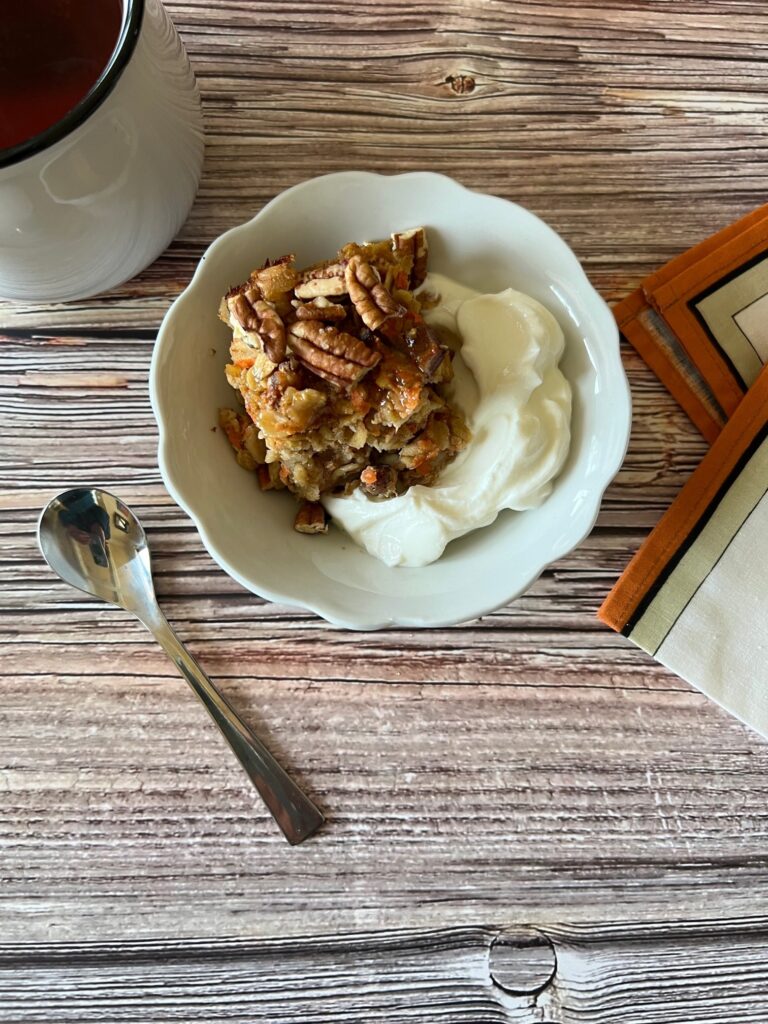Baked “Carrot Cake” Oatmeal

Locked into a daily bowl of oatmeal? Shake up the routine and bake your oats into an almost carrot cake situation. It tastes like dessert for breakfast. For more staying power serve it with Greek yogurt which pumps protein to at least 20 grams – my minimum for a meal.
The cardiovascular benefits of oats are well known. Oat’s soluble fiber, beta glucan, lowers “bad” LDL cholesterol by several mechanisms – binding it in the digestive tract so it doesn’t get into circulation, triggering the liver to take cholesterol from the blood to excrete, and serving as a prebiotic fiber, feeding the good bacteria in the lower intestine which helps with cholesterol metabolism (1).
How much soluble fiber do you need? According to the National Lipid Association, consuming 5-10 grams of soluble fiber daily may lower total and LDL blood cholesterol levels by 5-11 points (2).
Plus, diets rich soluble fiber may lower blood pressure, promote satiety, blood sugar control and weight management (1). Don’t limit yourself to oats. Reference 2 lists the soluble fiber content in other foods – barley, legumes, some fruits, vegetables and seeds.
The beta glucan soluble fiber in oats is also found in other grains, mushrooms, and yeasts. In addition to cardioprotective benefits, beta glucans stimulate the immune system to help fight respiratory and other diseases and have anti-cancer and anti-inflammatory benefits and protect against metabolic syndrome and obesity (8).
Other types of dietary fiber are important, too. Insoluble fiber such as found in the bran layer of oats and other grains, keeps the digestive system moving by adding bulk. Beyond solubility, dietary fiber is categorized by fermentability, viscosity and prebiotic properties (3).
Prebiotic effects have boosted dietary fiber into the limelight as science explores how it nourishes the “good” bacteria in the large intestine which in turn support the immune system, production and absorption of some nutrients, protect against colorectal cancer and pathogens. Emerging research reveals a role in gut-brain communications that influence mood and cognition (3,4).
Prebiotic effects have boosted dietary fiber into the limelight as science explores how it nourishes the “good” bacteria in the large intestine which in turn support the immune system, production and absorption of some nutrients, protect against colorectal cancer and pathogens. Emerging research reveals a role in gut-brain communications that influence mood and cognition (3,4).
The power of eating a diet rich in plant-based fibers was revealed in research looking at nearly 135 million person-years of data with over 4,000 adults (4). Those consuming the highest amounts of dietary fiber had a 15% to 30% decrease in all-cause and cardiovascular disease mortality and incidence of heart disease, strokes, type 2 diabetes, and colorectal cancer compared to people with the lowest intake.
In this study the sweet spot was between 25 and 29 grams of dietary fiber daily –more might provide greater risk reduction.
While over half of Americans say they try to consume fiber and whole grains (6), more than 90 percent of women and 97 percent of men do not meet recommended intakes of fiber (7): 14 grams for every 1000 calories or about 25 grams for adult women and 38 grams for men (5).
Eat a variety of minimally processed plant foods – vegetables, including legumes, fruits, whole grains, nuts, and seeds – each day to reap the benefits of different types of fiber. Supplements can help meet fiber gaps, but plant foods are packed with key vitamins, minerals, protein, and healthy fats, not to mention scores of phytonutrients.
Baked Carrot Cake Oatmeal starts you off with 4 grams (14% of the Daily Value) of dietary fiber. For more, add a sprinkle of chia or other seeds.
Baked “Carrot Cake” Oatmeal
Adapted from Bon Appetit’s Morning Glory Baked Oatmeal https://www.bonappetit.com/recipe/morning-glory-baked-oatmeal
Serves 8
1 large egg
2 ½ cups milk, non-dairy or dairy
⅓ cup pure maple syrup (use less if you like)
2 tablespoons avocado or other unflavored vegetable oil
Zest of 1 orange
1 ½ teaspoons pumpkin pie spice
1 teaspoon vanilla extract
½ teaspoon table salt (1 teaspoon Diamond Crystal kosher salt)
1 ½ cups grated carrot (about 1 large)
1 cup unpeeled grated apple with peel (about 1 medium)
½ cup dried fruit such as golden raisins, chopped pitted dates, or figs
2 ½ cups old-fashioned rolled oats (or 2 cups old fashioned rolled oats and ½ cup steel-cut oats)
1 teaspoon baking powder
1/4 cup chopped pecans or walnuts
To Serve (optional):
Chopped pecans or walnuts, pumpkin, chia, flax or hemp seeds
Greek yogurt, kefir or milk
- Place a rack in middle of oven; preheat to 375°.
- Break egg into a large bowl; whisk to blend. Whisk in milk, syrup, oil, orange zest, spice, vanilla, and salt. With a large spoon, stir in carrot, apple and raisins. Top with oats and baking powder. Stir to blend well. Spoon into an oiled 8-x-8-inch baking dish. Sprinkle with pecans.
- Bake until just set and top is golden brown, 35- 40 minutes. Let sit 5 minutes. Cut into squares or scoop out of pan.
- Serve warm, with toppings.
Tips:
- If you don’t have Pumpkin Pie Spice use 1 teaspoon ground cinnamon with ¼ teaspoon ground ginger, 1/8 teaspoon ground cloves and 1/8 teaspoon ground nutmeg or cardamom)
- Pineapple Variation: replace the grated apple with finely chopped pineapple or drained, crushed pineapple (juice-packed)
- Dairy Free Option: Replace egg with 1 tablespoon ground flax seed (flax meal) mixed with 3 tablespoons water. Use dairy-free milk.
- Protein addition: Add 1 ounce of your favorite protein powder and 2 tablespoons of water. Adds about 2 ½ grams of protein per serving.
- Do ahead: Oatmeal can be baked 5 days ahead; cover and chill. Or cut into squares, wrap airtight, and freeze. Thaw and reheat before serving.
Nutrients per serving (8 servings) with ½ cup nonfat Greek Yogurt: Calories 340; 18 g protein; 4 g dietary fiber (14% DV); 43 g carbohydrate; total fat 11 g; saturated fat 1.5 g; cholesterol 30 mg; sodium 300 mg; total sugars 25 g ; 8 g added sugars; 6% DV vitamin D; 25% DV calcium; 6% DV iron; 10% DV potassium.
References
- Sharing the Science Behind Oats Oldways Webinar. YiFang Chu, PhD, MBA FACN and Dawn Jackson Blatner, RD, CSSD. November 3, 2021 Webinar: The Whole Grain Picture: Sharing the Science behind Oats – YouTube
- Adding Soluble Fiber to Lower Your Cholesterol. National The Lipid Association.
- Dietary Fiber: An Update on Fiber. Sharon Palmer, MSFS, RDN, and Lori Zanteson. Today’s Dietitian. August/September 2020. Vol. 22, No. 7, P. 24.
- Carbohydrate quality and human health: a series of systematic reviews and meta-analyses. Reynolds A, Mann J, Cummings J, Winter N, Mete E, Morenga LT. Lancet. 2019;393(10170):434-445.
- Ask.usda.gov: How much (dietary) fiber should I eat? (usda.gov)
- International Food Information Council. 2021 Food & Health Survey. May 19, 2021.
- Dietary Guidelines for Americans 2020-2025.
- Clinical and Physiological Perspectives of β-Glucans: The Past, Present, and Future. Khawaja Muhammad Imran Bashir and Jae-Suk Choi. Int J Mol Sci. September 18, 2017; 18(9): 1906. Published online Sept 5, 2017.
© Lorelle Del Matto 2022
 About lorelle
About lorelle
Speak Your Mind